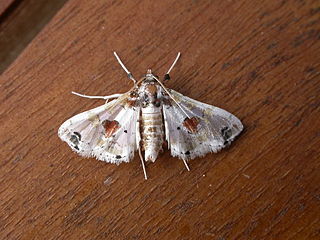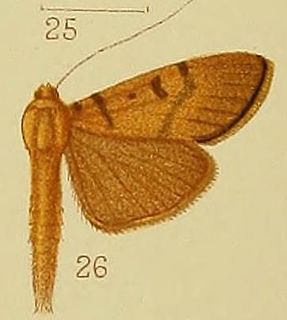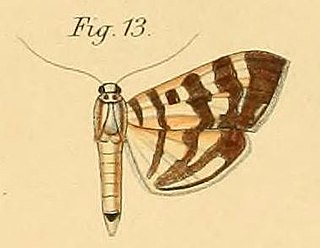
Leucinodes is a genus of moths of the family Crambidae. It was first described by Achille Guenée in 1854.

Syllepte is a genus of moths of the family Crambidae.
Pramadea ovialis is a moth in the family Crambidae that is found in subtropical eastern and southern Africa, including islands of the Indian Ocean. The species has also been recorded from West Africa.

Syllepte glebalis is a moth in the family Crambidae. It was described by Julius Lederer in 1863. It is found in Cameroon, the Democratic Republic of the Congo, Ivory Coast, Madagascar, Nigeria, Sierra Leone, Zambia and Zimbabwe.
Syllepte xylocraspis is a moth in the family Crambidae. It was described by George Hampson in 1912. It is found in South Africa.

Syllepte butlerii is a moth in the family Crambidae. It was described by Hermann Dewitz in 1881. It is found in Angola, Cameroon, the Democratic Republic of the Congo, Sierra Leone and Zambia.
Syllepte mesoleucalis is a moth in the family Crambidae. It was described by George Hampson in 1898. It is endemic to South Africa.
Syllepte nasonalis is a moth in the family Crambidae. It was described by George Hampson in 1898. It is endemic to South Africa.
Syllepte orbiferalis is a moth in the family Crambidae. It was described by George Hampson in 1898. It is found on Réunion and in South Africa.
Syllepte purpurascens is a moth in the family Crambidae. It was described by George Hampson in 1899. It is found in the Democratic Republic of the Congo, Kenya, South Africa and Tanzania.
Syllepte amelialis is a moth in the family Crambidae. It was described by Viette in 1957. It is found on São Tomé.
Syllepte albopunctum is a moth in the family Crambidae. It was described by Christian Guillermet in 1996. It is found on Réunion.
Syllepte erebarcha is a moth in the family Crambidae. It was described by Edward Meyrick in 1939. It is found in the Democratic Republic of the Congo.
Syllepte neurogramma is a moth in the family Crambidae. It was described by Edward Meyrick in 1939. It is found in the Democratic Republic of the Congo.
Syllepte nyanzana is a moth in the family Crambidae. It was described by Karl Grünberg in 1910. It is endemic to Uganda.
Syllepte patagialis is a moth in the family Crambidae. It was described by Zeller in 1852. It is found in Cameroon, the Democratic Republic of Congo, South Africa and on the Comoros.
Syllepte sakarahalis is a moth in the family Crambidae. It was described by Hubert Marion and Pierre Viette in 1956. It is endemic to Madagascar.
Syllepte secreta is a moth in the family Crambidae. It was described by Edward Meyrick in 1936. It is found in the Democratic Republic of the Congo.
Syllepte straminea is a moth in the family Crambidae. It was described by Arthur Gardiner Butler in 1875. It is found in South Africa, where it has been recorded from KwaZulu-Natal.
Syllepte thomealis is a moth in the family Crambidae. It was described by Viette in 1957. It is endemic to São Tomé.



